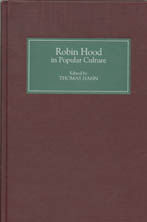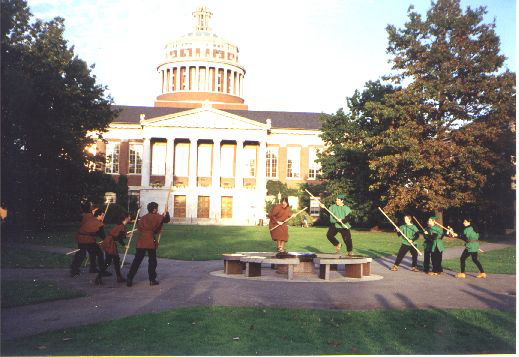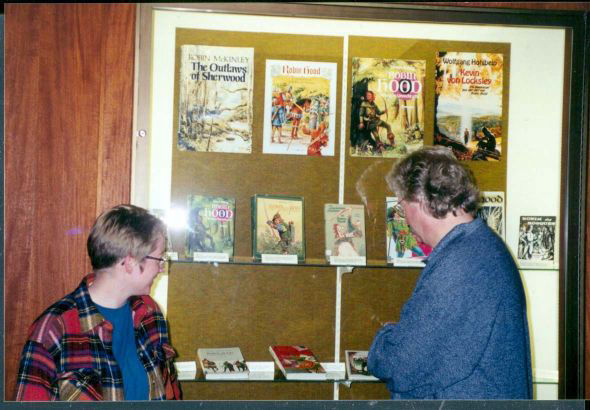Many approaches to the legend
Robin Hood in Popular Culture: Violence, Transgression and Justice is a new collection of the papers that were originally presented at the 1997 conference on Robin Hood studies. It's a fascinating collection of articles on a wide variety of subjects.
Thomas H. Ohlgren's paper "The 'Marchaunt' of Sherwood: Mercantile Ideology in A Gest of Robyn Hode" takes a microscope to one of the earliest Robin Hood ballads, and it makes some intriguing suggestions about who the ballad was originally intended for. And while other papers examine some of the ballads, many other aspects of the legend are explored in the rest of the book.
Kevin Harty takes a look at Robin Hood films; Sherron Lux writes on the Maid Marians in film and television, and Laura Blunk examines the popular Robin of Sherwood television series. David Lampe explores Robin Hood novels. Sarah Beach's paper is on Green Arrow, a comic book superhero inspired by the legend. Linda Troost looks at 18th century Robin Hood musicals, Yoshiko Ueno writes about a 1927 radically left-wing play from Japan, and Gary Yershon shares his experiences in crafting a modern day Robin Hood play. Lorraine Stock examines Green Man imagery in the legend, and Kelly DeVries looks at longbow archery. Marcus Smith and Julian Wasserman provide a fascinating paper "In the Sheriff's Court: Robin Hood and American Jurisprudence, Or Who Is This Robin Hood and Why Are All Those Lawyers Saying Such Nasty Things about Him?" And then there are papers by Frank Abbott, Michael Eaton, Stuart Kane, John Marshall, Evelyn Perry and Lois Potter as well.
Also, this collection includes the plenary addresses by two of the foremost Robin Hood experts. Professor R.B. (Barrie) Dobson's Rymes of Robyn Hood ballad collection has been a classic for years. His contribution to this volume is "Robin Hood: The Genesis of a Popular Hero" -- an overview of the possible origins of the Robin Hood legend, written with more insight than the various real Robin Hood books out there.
Professor Stephen Knight, who wrote a landmark 1994 book on Robin Hood and has edited various anthologies since then, uses his address to look at where Robin Hood scholarship at present and offers suggestions about lines of inquiry that should be perused in the future. His article is called "Which Way to the Forest? Directions in Robin Hood Studies".
Many of the papers in this book are very readable. Some, however, I do find a bit "literary" for my tastes. But overall, Robin Hood in Popular Culture is an informative and interesting collection of Robin Hood studies.
[I notice that my tastes bent a lot more toward the literary side of the legend since I first wrote the article many years ago.]
Unfortunately, the book is too specialist for the general reader. If you're looking for a good introduction to the legend, I'd recommend works like Stephen Knight's Robin Hood: A Complete Study of the English Outlaw [or Knight's subsequent Robin Hood: A Mythic Biography], J.C. Holt's Robin Hood and R.B. Dobson and J. Taylor's Rymes of Robyn Hood. But if you're familiar with those books and want to learn more, Robin Hood in Popular Culture is worth reading. I also think it would be a good book for specialists in related disciplines to consult. For example, an expert in 18th century theatre would enjoy Linda Troost's look at the Robin Hood musicals of that time.
As great an addition to Robin Hood studies as this book is, it's really (and unavoidably so) a pale shadow of the conference that inspired it.



Contact Us